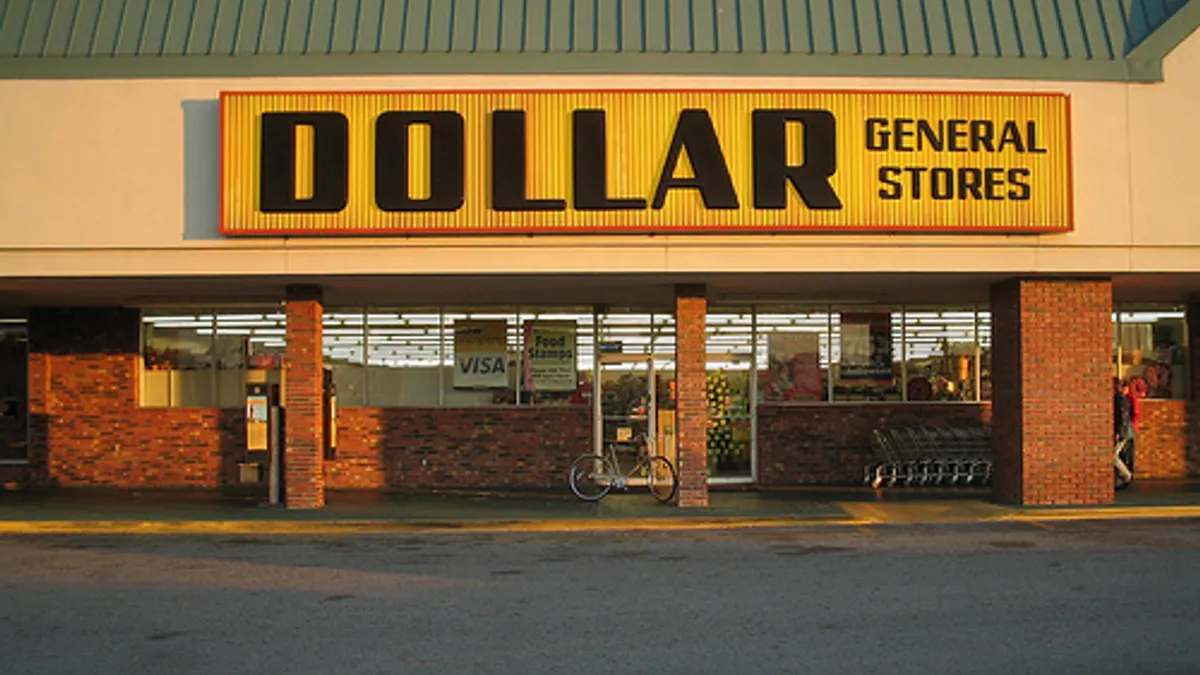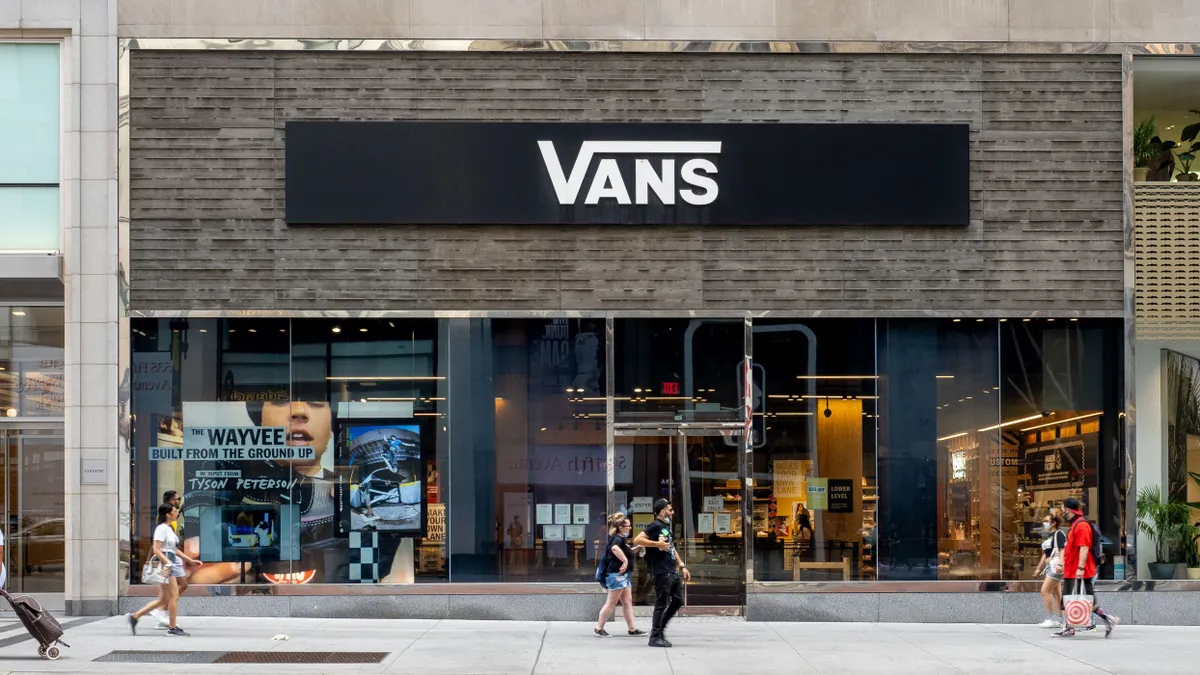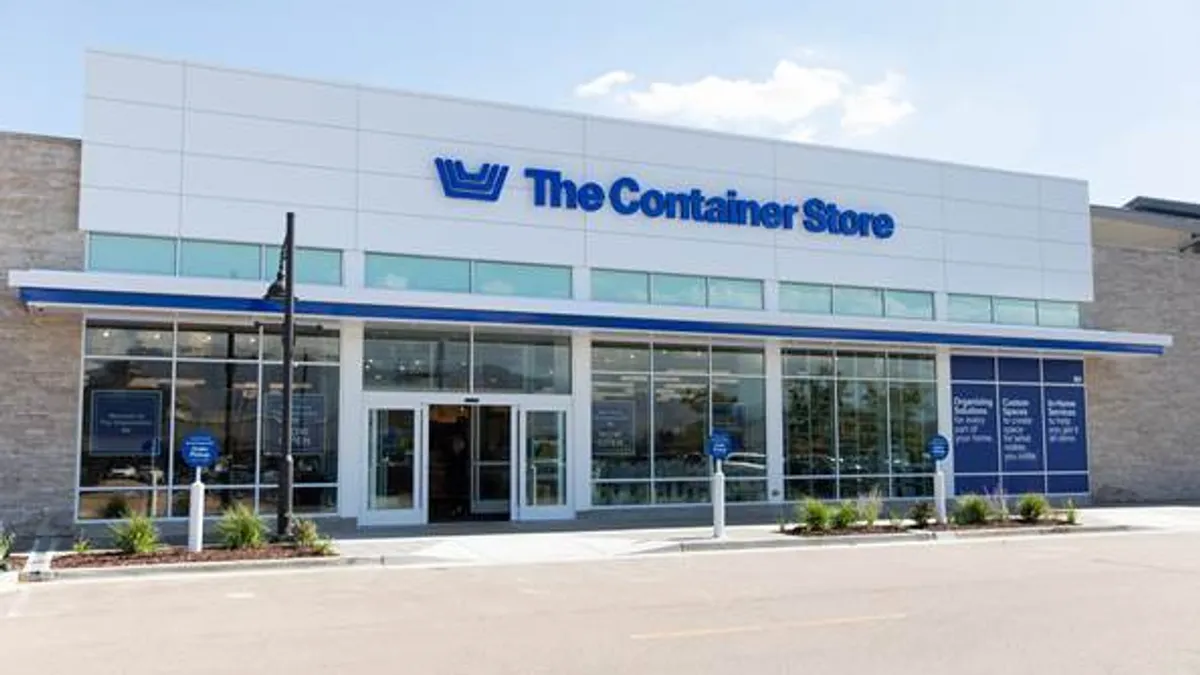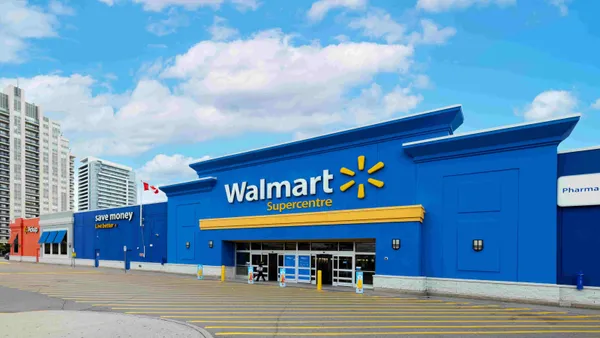Just as struggling chains like The Limited, Sears and Macy's are closing stores, one retailer is gearing up for the largest U.S. expansion program in recent memory.
Dollar General confirmed to Retail Dive it intends to move forward with its plan to build an unprecedented 1,000 new stores in 2017 — or, as a Buckingham Research analyst pointed out, about 2.5 stores per day.
Already in 43 states, this will bring Dollar General into 44 (with the addition of North Dakota) and continues its ongoing initiative to fill in spaces across the country the retailer has identified as fertile ground. A company spokeswoman declined to provide granular detail on where this latest group of stores will be planted.
To many Americans it may seem the Goodlettsville, TN-based dollar store chain’s black and yellow sign is already a fixture in their neighborhood, and such observations are not without merit. Dollar General has more stores across the country than any other retail nameplate — 13,205 at last count. That compares to Wal-Mart at 5,229, Target at 1,803 and CVS at 9,600. Its toughest rival, Family Dollar, has 7,964 stores, and Family Dollar’s sister Dollar Tree has 6,320. By this time next year there will be about as many Dollar Generals in the U.S. as McDonald’s restaurants.
An aggressive growth plan
As Dollar General forges full speed ahead with its expansion plans, who should be on heightened alert? Pretty much any retailer that sells core, everyday consumable goods. Discounters, drug stores, supermarkets and other dollar store players are all a target for market share.
“The main reason for aggressive unit growth at Dollar General is their belief they have the opportunity to grab specific locations while their biggest competition [Dollar Tree and Family Dollar] is going through a merger, and therefore pulling back on new unit opens,” John Zolidis, retail analyst for Buckingham Research, told Retail Dive. In 2015, Dollar General controlled 56.4% of the dollar store market, followed by Dollar Tree with 21.6% and Family Dollar with 14%, according to Nielsen data.
“[Dollar General is] fantastic at executing,” said Zolidis, remarking on what has been driving the growth. “They do a good job at managing the business and the stores look really good. I visit a lot of dollar stores. They are always bright, clean and well-stocked. And they have a really good assortment in a small space.”
"[Dollar General has] the opportunity to grab specific locations while their biggest competition [Dollar Tree and Family Dollar] is going through a merger."

John Zolidis
Retail analyst for Buckingham Research
Dollar General's model, a combination of low prices and convenience, has attracted enough shoppers to produce the cash flow necessary to fuel its rampant growth. A standard 7,300 sq. ft. Dollar General store costs about $250,000 to build, and pays for itself within 1.7 years, according to company reports.
In 2016, Dollar General opened 900 new stores on top of the 730 units opened in 2015. Meanwhile, the company has been retrofitting a bulk of mature stores into its latest DG16 format that features a new checkout area to ease congestion and presents more $1-priced products near the front. Always fine-tuning assortments, it has been expanding profitable departments such as perishables, health and beauty, party and stationery. Stores carry about 10,000 SKUs and Dollar General knows the direct profitability of each. On average, Dollar General’s prices are on par with discounters, 20% less than at grocery stores and 40% less than at drugstores, according to statements from the company.
A growing customer base
A widening customer base has also helped spur Dollar General's vast development. As CEO Todd Vasos told analysts at its 2016 investor day conference, the current economy “continues to create more of our core consumer each and every year,” according to a Seeking Alpha transcript of the event.
“[I]f I was to wager, I would tell you that as we continue to move through the years, this economy is going to continue to create our core consumer and I’m sure we are going to see new and better opportunities start to emerge in our real estate portfolio that we don’t even see today,” Vasos said. Along with its principal budget shoppers, Dollar General has been seeing more millennials and trade-down shoppers come through its doors.
“Rolling out 1,000 new stores is a bold aspiration, but I believe they have the capability to do it.”

Michael Brown
Partner in retail practice at global consulting firm A.T. Kearney
Until the second quarter of 2016, Dollar General has consistently posted same-store sales growth. But it too has hit a slippery spot, with same-store sales softening in the last two quarters, hurt by price deflation in some food categories and a reduction of SNAP benefits among shoppers. To combat that, it has implemented lower prices on 450 key items in 17% of its store base in hopes of building traffic. As it determines what works and what doesn’t it may apply discounts elsewhere.
Still, overall financials remain impressive as net sales grew 5.9% to $15.98 billion for the nine months ended Oct. 28, 2016, with net income of $837 million up from $789 million from the year earlier period. Full-year 2015 net sales grew 7.7% to $20.4 billion, with net income of $1.7 billion, up from $1.07 billion.
Despite the same-store sales hiccup Dollar General is moving right ahead with its massive store build out. Michael Brown, partner in retail practice at global consulting firm A.T. Kearney, is not too concerned with the recent same store sales slump, and understands why Dollar General is pushing ahead. “This is just an impact of the economy. There has been pressure on retailers of all sizes,” he said.
Brown pointed out that retailers like Dollar General need to have a physical space, because selling online isn’t really a financial option. “Having stores is the cheapest way to service their customer. They can’t be shipping products at their low price point,” said Brown. “Rolling out 1,000 new stores is a bold aspiration, but I believe they have the capability to do it.”
Room for more discount retail
At a time when many retailers are closing physical stores and ramping up digital operations, off-price retail offers a healthy environment with room to grow. Robin Lewis, CEO of The Robin Report, a retail strategy publication, has long espoused there is room for more discount retail.
“They have a huge runway for expansion. There is an enormous underclass and they are not being served by traditional retail," Lewis told Retail Dive. "They don’t have any disposable income to speak of. If they are employed, they are marginally employed at best, mostly service jobs — flipping hamburgers. For those that do have jobs they are not participating in the migration to the internet. They can’t do business on the internet without a credit card.”
“In good times our customers have a little bit more to spend and in tougher times, they need us more.”

Todd Vasos
Dollar General CEO
With increasing Kmart store closures removing shopping options, and the high price of gas causing travel challenges to get to the nearest Wal-Mart, a dollar store popping up in a neighborhood solves a problem, Lewis pointed out. “They can walk there or get there by public transportation.”
While its primary model is its standard 7,300 sq. ft. store, Dollar General earlier this year revealed plans for a smaller more urban format, coined DGX, which will be around 3,400 sq. ft. It has also been learning about perishables categories with its handful of larger and fresh food oriented Dollar General Market and Dollar General Plus stores. Of the 1,000 stores coming in 2017, most will be its core box with 150 to 160 of the new smaller format.
“Our business generates significant cash flow and we are in a position to invest in accelerated store growth as well as mature store base while we continue to return cash to shareholders through consistent share repurchases and anticipated dividends,” Dollar General’s Vasos told analysts in December. “We remain very excited about our business overtime.”
In a simple phrase, that Vasos often repeats, he wraps up why the business model works: “In good times our customers have a little bit more to spend and in tougher times, they need us more.”



















